Peter MALONE
Saturday, 18 September 2021 19:43
Sand Pebbles, The
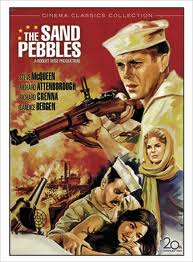
THE SAND PEBBLES
US, 1966, 193 minutes, Colour.
Steve Mc Queen, Richard Attenborough, Richard Crenna, Candice Bergen.
Directed by Robert Wise.
The Sand Pebbles was one of the big films of 1966, gaining many Oscar nominations including best picture. It was nominated for many other awards and Richard Attenborough won a Golden Globe for best supporting actor. Steve Mc Queen himself was nominated as best actor.
The film is set in China in 1925, a time of great turmoil with the warlords and the anti-imperialist revolutionary moves. It was only twenty-five years before the communist revolution and the ascendancy of Mao Tse Tung. (Somerset Maugham’s The Painted Veil takes place in the interiors of China in this same era and this is well portrayed in the 2006 version with Edward Norton and Naomi Watts.)
Steve McQueen? comes from the United States to be in charge of a patrol boat. His American ideas clash with the Chinese way of doing things, rice bowl diplomacy, saving face. He has to learn what it is to be an American in China. Richard Attenborough and Richard Crenna as well as the Japanese actor Mako are strong in support. Candice Bergen, at the beginning of her film career, is the female lead.
The film was directed by Robert Wise who had begun as an editor with Val Lewton in the 1940s, made some horror films but then moved into mainstream films of many genres including The Day the Earth Stood Still. In 1961 he won an Oscar for best director of West Side Story and again in 1965 for The Sound of Music.
1. Was this an enjoyable adventure film? Its epic size? As successful human drama? Was it a successful big budget spectacle?
2. The meaning and tone of the title? The focus on the boat and the men? The need for audience in such a big and long film?
3. The quality of the panavision filming, the colour and locations, the musical theme and its use throughout the film, the impact of the stars? Why do audiences enjoy these ingredients? In films like this?
4. Audience response to the Chinese setting? Interest in China, in the Chinese past, in America's role in China this century, the exotic atmosphere, of Americans away from home? How well did the film use its Chinese atmolsphere and settings?
5. The importance of the war background for the film? The film as pervaded by an atmosphere of hostility? How unreal compared with American backgrounds of the West did this war and hostility seem? The disruptive effects on a country, its people, on visitors like the Americans? The effects of war?
6. How important was the commentary on American activity in the East? Chinese hostile attitudes towards the Americans? How justified were these? How honourable was the American's behaviour because of their involvement?
7. How important was heroism in this film? The nature and quality of a hero? The need for heroics? For other people? Issues of life and death and personal involvement? The importance of the cause? The meaning of life, suffering and death?
8. How attractive wa s Steve McQueen? as the hero of this film? The Mc Queen type hero? The orphan. the misfit at home, working to save people away from home, laconic, questioning orders, difficult to work with, involved in fights and friendship? The impact of the war atmosphere which was bigger than the hero? The emotional changes in his life? The demands made in terms of life and death? Could audiences identify with this ? Or could they merely admire it?
9. How important for the film was the picturing of the morale of the Americans, life on the gunboat, the fights amongst the crew, relationships with the Coolies. life on shore, the hostilities of the men amongst themselves in the face of war and Chinese hostility? The repurcussions on McQueen?
10. How realistic was the love interest in the film? The relation between Holman and Shirley? The way that this was presented? The initial encounter, the friendship, Shirley's charm, her dedication to her work, being rescued? The effect of sharing, danger, of getting to know one another, the visit to the zoo and their talking? The impact of Shirley's return on Holman? As a motive for him to go and save her? His dying for her? How attractive was Shirley as a heroine? As an American away from home, doing good?
11. How important was the character of Frenchie? As a contrast to Holman? His work on the ship? His friendliness? The impact of his love for Maly? His devotion to her, his escaping from the seige, his marrying her, the importance of his dying for her? The meaning of his life?
12. The importance of such sequences as the fights and encounters in the brothel, the marriage ceremony, the incidents and fights on the ship?
13. What use was made of various incidents to make points about war and men in war? The seige of the ship, the torturing of the Chinese, the forcing of the boom?
14. How violent was the film? Was it appropriately violent for a war film? The fights themselves? The coolie being tortured? Holman shooting him, the fighting at the boom, the axe killing, the final shooting? What was the purpose of such violence in the film?
15. The significance of the captains decistons about the role of Americans? His relationship with Holman? What kind of man was the captain? His trying to follow orders, his decisions. his seeking some kind of heroism? Was he right to have ignored orders and to have attavked the boom? What was he trying to prove? The significance of his death?
16. The impact of the final violence: the death df the missionar:y'and the betrayal of all he stood for, Shirley's decision to go, the captain's death and its meaning, Holman's death and its meaning?
17. How much was the film to be taken as an ordinary adventure spectacle? How much as a war film and a commentary on the meaning of life and death in war?
Published in Movie Reviews
Published in
Movie Reviews
Tagged under
Saturday, 18 September 2021 19:43
Sanjuro
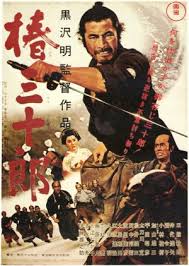
SANJURO
Japan, 1962, 96 minutes, Black and white.
Toshiro Mifune.
Directed by Akira Kurosawa.
Sanjuro is one of the several films made by Akira Kurosawa with star Toshiro Mifune. Many of them had samurai stories, especially The Seven Samurai, Rashomon, Yojimbo.
The film is very much an 18th century story of corruption, corrupt authorities, clans, kidnappings, samurai coming to the aid of those in need, action.
By this stage, Toshira Mifune was expert at acting in this kind of film. Kurosawa had become a world leading director by this time, having begun his career in the 1940s and continuing it with many outstanding films in the 1950s. Variations on the theme occur in Throne of Blood, his version of Macbeth. He also did some contemporary stories, for example, High and Low. Towards the end of his career, he moved to colourful ethnic films like Dodeskaden and Dersu Uzala. However, his final films included Kagemusha and Ran (his version of King Lear). His films were a great influence on Sergio Leone whose film, A Fistful of Dollars, was an adaptation of Yojimbo.
1. How interesting a film was this for non-Japanese audiences? Why? What was impressive about the style of the film? Black and white photography, musical background, use of Panavision?
2. How important was the Samurai atmosphere of the film? The legends of Japanese history? The village and life within the village? Power and violence and corruption? The Samurai as saviours by violence? The loyalty this aroused, admirationl? Did the director admire the Samurai and his style of life? Does the audience of this film? Why?
3. What insight into Japan and its history, its characters and style of life, its codes and its manners do films like this give? Why?
4. Comment on the presentation of the town in this film - its corruption, the roles of good and evil?
5. How important were the idealistic young men in this film? Their impulsive behaviour. Their idealism about good, the fact that they were deceived by appearances and could not see reality? The number of mistakes they made, even at the risk of death? what comment was being made on Samurai in this film?
6. How attractive a Samurai hero was Sanjuro? His overhearing the young men, his deciding to intervene, his wisdom and experience in contrast with theirs? His ability and ease? His relating with the young men? His having to make good their many mistakes? The young men's loyalty to him? The insight into relationship between disciple and master?
7. What insight into society did the presentation of this town give? Appearances and realities of officials? Corruption and goodness? The corruption of power with violence? The style of behaviour in the town?
8. With what admiration did the director present Sanjuro with his devices and wit, his encountering dangers, his saving people? Which incidents best illustrated this for you?
9. Comment on the staging for the fights. the implicit violence, violence as a saving of people? Did this seem overdone or was it appropriate for Sanjuro?
10. American writers have seen a link between the westerns and the Samurai stories and films. Is this a useful insight into understanding film like this?
Published in Movie Reviews
Published in
Movie Reviews
Tagged under
Saturday, 18 September 2021 19:43
Sam Whiskey

SAM WHISKEY
US, 1969, 96 minutes, Colour.
Burt Reynolds, Angie Dickenson, Clint Walker, Ossie Davis.
Directed by Arnold Laven.
Sam Whiskey is a routine western from the late 1960s. Burt Reynolds was emerging as a popular star at this period and the 1970s were very favourable for him. Angie Dickinson had been popular in many films from the late 1950s. They are an enjoyable pairing. He is a talent for hire. She is a widow who wants to transport the gold bullion stolen by her husband to the mint before it is noticed. The supporting cast includes Clint Walker and a comic Ossie Davis.
1. Was this an enjoyable film? Why? How good a ballad of Sam Whisky was it? How much of a hero was he? How sympathetic? A man of the West? How effective was the story told during the credits? The visual communication of the story and creating Sam as a hero? How ironic was the follow up to this presentation of a hero?
2. Was the film a good comedy? How good humoured was it? What best illustrates this?
3. Was it a good Western? What conventions of Westerns did it best use? How important was the ironic tone of the screenplay? How important was the reversal of the bank robbery theme? The return of the money to the safe rather than stealing it? How funny did this make the film? What comment on Westerns did it make? What comments on justice? What attitudes of justice and attitudes towards Westerns did the film presuppose in its audience?
4. How did the humour of the bath sequence at the beginning offset the tone of the film? How did it show that Sam Whisky was non-heroic?
5. Jedadiah? What kind of person was he? Black blacksmith? How necessary was he for the project? What help did he offer for the job? Why were he and Sam such friends?
6. Bandy: How humorous a character was he? His inventions? How ingenious and humorous were they? The fact that he was dumb? How was he essential to the project? His friendship with Sam?
7. Laura: typical romantic heroine of a western? The personality of Angie Dickinson? The irony of her proposal? Her concern for following it through? Her relationship with Sam? Her contribution to the working out of the plan?
8. How ingenious was the plan to raise the money and return it? The irony of spending so much ingenuity in getting the money back?
9. How did the film use the journey to the money and the journey back as giving a tone to the film? How was the tone enhanced by Sam Whisky’s song? Was this important for the impact of the film?
10. The sequence of the getting of the gold? How successful? The comment on violence and greed in the ambush and the attack?
11. How did these people contrast with the group trying to get the gold back? How entertaining were the sequences where the gold was returned, in all the complexity, Sam taking the inspector's place, the accidents that happened with the mint, the close shaves?
12. How happy was the ending? Did they deserve a happy ending? How enjoyable a film was this?
Published in Movie Reviews
Published in
Movie Reviews
Tagged under
Saturday, 18 September 2021 19:43
Salzburg Connection, The

THE SALZBURG CONNECTION
US, 1972, 93 minutes, Colour.
Barry Newman, Anna Karina, Klaus Maria Brandauer, Udo Keir.
Lee H. Katzin.
A rather complex and complicated espionage thriller from the novel by Helen Mc Innes. Filmed very attractively in Panavision in Austria. The film utilizes the atmosphere of Austria for the adventure. However, the human happenings are quite complicated and need attention to follow. The American hero is Barry Newman - Petrocelli from the popular televison series. The noted French actress Anna Karena is conventional in her leading lady role. The film uses local stars mainly for supporting roles especially Udo Keir - later to be famous in Flesh for Frankenstein and Blood for Dracula. The direction in by Lee H. Katzin, a television director as well an of features such as Whatever Happened to Aunt Alice?
1. An interesting and entertaining espionage thriller? The value of such espionage thrillers as entertainment? Their relationship to reality?
2. What conventions of the genre did the film use? The establishment of characters, mysterious setting, the strands of mystery needing resolution, atmosphere of menace, international agencies and doublecrosses, murder and violence? The bringing together of the themes for an appropriate resolution? How satisfying was this film in these regards?
3. The contribution of the colour photography, Panavision, the Salzburg and Austrian settings? The understated score? The importance of the special effects? The use of freeze frames and slow motion for dramatic effect - appropriate or not?
4. How plausible was the plot? For the purposes of an espionage film? The Nazi documents buried in the lakes in Austria? The recovery of such chests? The repercussions of the discovery of such names on lists - for Germany, Austria, the United States bureaucracy, for neo-Nazis, for Israel, Russia and Red China? How well did the film illustrate this? The recovery of the chest for greed and money? The number of people involved and the reasons for their involvement? The number of chases, murders? The involvement of Mathison on his holiday? The involvement of Anna Bryant and her brother? The meeting of all these spies and their rings in Austria? The build?up to the final climax? How real, contrived?
5. Mathison as credible hero? Ordinary American lawyer, serious attitude towards life, presence in Austria on holidays, doing a favour for his friend? His involvement with Anna Bryant and Johann Bryant? The encounter with Elissa? With the C.I.A., with the Austrian Intelligence? With the K.G.B.? His attraction towards Anna and trying to save her, the several encounters with Elissa? His room being bugged, his life being threatened? The phone messages from Zurich and his further involvement? Danger to his life for example in his constantly being followed by so many people around Salzburg,
his going on the chair lift? his final involvement with the C.I.A. and the success of his mission? The finale and going off with Anna? A credible hero in himself, for this kind of film? How sympathetic a hero?
6. Anna as heroine? The credibility of her marriage to Bryant, her knowledge of the chest, her devotion to her brother? The shop, her fear and growing reliance on Mathison? The growing number of deaths and her fear? Her anxiety for her brother? Her decision to go with him at the end? An attractive heroine?
7. The many villains: Elissa and the plausibility of her stories and her change when she made telephone calls, her cool command especially at the end and her being deceived by the bomb? Her K.G.B./China associate? The various villains following Mathison around Salzburg? The brutal couple who murdered Bryant, tortured Johann?
8. Johann as a credible character - sharing in the recovery of the chest with Bryant? His love for his sister, suspicion of Mathison, his girl friend? His refusal to give information when tortured? The rescue? The Austrian Intelligence man and his role at the villager his name being on the list, his knowing that the chest would be blown up, the inevitability of his heroic death in the rescue?
9. The C.I.A. man and his control and quick thinking to save the chest?
10. Comment on the special effects - the special use of the camera for the changing of mood?
11. How well handled were the dramatic crises, torture sequences, murders? Suspense?
12. Memorable sequences - the slow car chase through the city, the chair lift and the expectation that Mathison would be killed and his follower being murdered?
13. The basic espionage themes of human nature, the image of good and evil, right and wrong, heroism, romance? The image of international espionage and agents? A satisfying thriller?
Published in Movie Reviews
Published in
Movie Reviews
Tagged under
Saturday, 18 September 2021 19:43
San Francisco
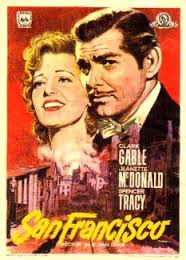
SAN FRANCISCO
US, 1936, 115 minutes, Black and white.
Clark Gable, Jeanette Mac Donald, Spencer Tracy.
Directed by W. S. Van Dyke.
San Francisco was one of the big MGM hits of 1936.
It tells a Barbary Coast story, the Paradise gambling halls run by characters like Clark Gable’s Blackie, the Tivoli Opera House with singers like Mary Blake, played by Jeanette Mac Donald, and priests like Spencer Tracy’s Father Tim Mullin. The Barbary Coast had a reputation for lawlessness and liveliness.
The film is a melodrama, with Clark Gable putting pressure on Jeanette Mac Donald to be a singer at his gambling hall whereas her heart was in the opera house. However, she marries him. This aspect of the film is a little unbelievable: Jeanette Mac Donald and Clark Gable were not an immediate couple for consideration. However, Spencer Tracy is able as the priest – and he was to play Father Flanagan in Boys’ Town and Men of Boys’ Town as well as the priest in The Devil at Four O’ Clock, 1962.
The film is best remembered, perhaps, for the presentation of the San Francisco earthquake. It had happened only thirty years prior to the making of the film and so was still in the public memory. The special effects for 1936 are quite spectacular and the film was nominated for sound engineering for an Oscar. The film has the song ‘San Francisco’ – sung in a rousing way by Jeanette Mac Donald – and resumed at the end of the film with the focus on the modern city of 1936.
1 . How enjoyable a film? Why has it lasted so popularly since the thirties? Why is it a classic of the thirties? What film values and styles of the thirties does it portray? The black and white photography, the music and songs, the big studio sets, the special effects, the impact of the stars, the sentiments for Americans, the pride and entertainment values?
2. How did San Francisco itself become a central character in the film? The history and its frontier sensuousness? The change into a civilized city? pride in the city, the relishing of the frontier past, the sijnificance of the chances? Did the city change for the better? The importance of traditions and history for a city and for a people? The impact of the song and its continued use throughout the film, San Francisco spirit? how well portrayed was the life of San Francisco and the city as a microcosm of America at the turn of the century? Blackie and the Barbary Coast, its style and roughness, gambling end happiness? The contrast with the Burleys and Nob Hill, pioneers who became rich and aristocratic? The opera house and the intensive culture? The old buildings and the fire hazard and the lack of organization? The politicking? Fr Tim, his life and history, his style and the role of the Church? How typical of America around 1900?
3. The importance of the initial New Year celebrations and atmosphere of festivities? The foreboding of disaster? The New Year celebrations as summing up the life of the city? The implications of the fire and its influence?
4. How attractive a hero was Blackie? Clark Gable's personality and style? The film's reliance and use of this? Blackie as a symbol of the old San Francisco? As an attractive but sceptical man? Generous and honest? His relationship with Burley, the other owners of inns and taverns, his strong will? The role of gambling and his place, the girls, the style? The importance of the confrontation with Mary and the challenge to him? The change in attitude and love? His response to the politics and the politicking? discovery of the opera and the change that Mary made? His generosity with her contract? The fact that he was moulded in a particular style and could not get out of it? Wanting to mould Mary in this style and own her? His pride? The relationship? With Father Tim - the significance of sparing with him? The impact of Mary's engagement to Burley, the police taking his place, the winning of the competition, the earthquake and its chance in his life? How convincing was his seeking out of Mary and his praying?
5. How attractive a heroine was Mary? The use of Jennette Mac Donald's personality and style? Her singing capabilities? As a person from Colarado with honesty and integrity? Her reliance on Blackie? Changing him and his changing her? Her entering into the singing, San Francisco? Her opera ambitions and their fulfilment? Singing in the church? Her relationship with Father Tim and his interest in her? Why did she become engaged to Burley? The importance of the discussion with Mrs Burly and the history of San Francisco? Mrs Burly and her pattern for marrying for Mary? The impact of Blackie’s humiliating her when she won the competition? The impact of the earthquake on her and her helping others? Was she a convincing heroine? How attractive was her singing? Was this important? For the thirties audiences?
6. How interesting was Spencer Tracy’s portrayal of the priest? The humanity, the official ecclesiastical role? Sparring with Blacky? provoking Blacky and differing from him? The explanation of their backgrounds? His common sense, passion, supporting Mary against Blackie, bringing them together at the end?
7. How interesting was the portrayal of the aristocrats like Burley? The ‘big deals' and the possession of power? The hazards of the buildings and not changing the style of the Barbary coast?
8. Comment on the verve of life in San Francisco? ordinary people, the police, the final competition?
9. How dramatic was the earthquake? How well filmed? The use of special effects, the impact at the stage of the film? Its repercussions on people's lives? Its realism, the dynamiting of buildings? The destruction of the Burley house?
10. How convincing was the reassessment of the people and the city after the quake?
11. The sense of resolve and ambitions for the future? The high morale of the finale song and procession? How convincing was this? How necessary is morale boosting?
12. How strong was the film on entertairment values? On human values? A positive outlook on life and people?
Published in Movie Reviews
Published in
Movie Reviews
Tagged under
Saturday, 18 September 2021 19:43
Samson and Delilah/ 1949
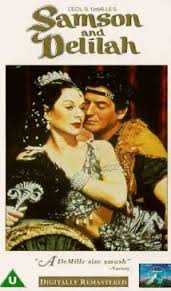
SAMSON AND DELILAH
US, 1949, 131 minutes, Colour.
Hedy Lamarr, Victor Mature, Angela Lansbury, George Sanders, Henry Wilcoxon, Fay Holden.
Directed by Cecil de Mille.
With Samson and Delilah one might say this is Cecil B. de Mille film-making personified. In the 1920s, after ten years as a director, de Mille made a breakthrough in biblical films with The Ten Commandments. He followed this up in 1927 with the spectacular King of Kings, one of the main Jesus films of the era. In the 1930s he moved on to The Sign of the Cross, early Christianity as well Cleopatra, both with Claudette Colbert. After that he turned his attention to the west with The Plainsman, Union Pacific, Unconquered. In 1949, he persuaded Hedy Lamarr to play Delilah and invited strong man actor Victor Mature to be Samson. They were a great box-office attraction.
George Sanders and Angela Lansbury offered more substantial support and Henry Wilcoxon, a regular with de Mille films, is also in the cast.
Sets and costumes are spectacular. De Mille himself appears at the beginning of the film to introduce it and show that he was making a religious film, despite the spectacle.
The film follows the biblical story, more or less, with an emphasis on Samson and Delilah and their love for each other as well as the betrayal. The destruction of the Temple of Dagon at the end is quite memorable.
There was a television version of the story, not particularly biblical, in the 1980s with Belinda Bauer and Antony Hamilton. However, there was a more serious presentation in the 1990s, the film directed by Nicolas Roeg. This time Elizabeth Hurley, a choice in looks rather than acting, is Delilah with Eric Thal as Samson. However, the supporting cast is more interesting as it includes Dennis Hopper, Diana Rigg, Daniel Massey and has a young Jonathan Rhys Meyer as the teenage Samson.
1. What constitutes the appeal of the Biblical spectaculars? Their spectacular nature? Their size? The biblical theme? Religion and spectacle?
2. What can be said of Cecil B. DeMille's view of history from this film? His attitudes towards spectacles? Towards the bible? His view, of the importance of great men in history?
3. Comment on De Mille's vision of Palestine versus the Philistines and the social and religious upheaval and their relevance for today. Did he make good his claims for the teaching value of this film? How?
4. How interesting was Samson as a hero? His strength and religion? His loyalty and fickleness to his family and country? His role as a judge? His clashes with the Philistines and taunting of them? Was he a law unto himself? Too independent? Was he a great man?
5. Samson as influenced by his love? His arranging for the marriage? His discovery of distrust and hatred? What effect did this have on him? How much was his marriage a taunting of the Philistines?
6. How interesting a person was his wife, Semadar? Did he really love her? Did she love him? Why did she agree to deceive him with the riddle? Was her death part of poetic justice?
7. What were your first impressions of Delilah? How did Cecil B, DeMitle? understand her? And present her: as an ordinary woman, as a temptress? Her attraction for Samson? Why was he not initially attracted? The importance of the sequence where she accompanied him on the hunt for the lion? Why was she so jealous when frustrated? The nature of her lies and her revenge? Did this alienate her from the audience? Why?
8. Did the film make satisfactory use of the tradition of Samson's strength: the lion, his attaining of the sets of clothes and his clashes with the Philistines, the strength of his hatred in his years of wandering, his ravaging of the Philistines, his escape with the jawbone of an ass, his finat collapsing of the temple? What point was being made by the presentation of Samson's strength and the loss of it?
9. How credible was Delilah's seducing of Samson? Did she really love him? Did she really hate him? Why did he give her the secret of his hair? The dramatic importance of the sequence where she cut his hair?
10. Were the Philistines presented interestingly? The Saran? His suave cynicism in ruling the Philistines? The Captain of the Guard and his ambition to marry Semindar? As a counterpoint to Samson? The religious overtones of the Philistians as pagans? Their attitudes towards the true religion? Towards Samson's God? Their cruelty in blinding Samson and putting him on the mill? How violent were these sequences? How horrifying? Did it gain audience sympathy for Samson and dislike of Delilah? Delilah's discovery of what had happened and its effect on her?
11. How important was the mill experience for Samson? His despair, his prayer to God, the impact of it on Delilah? Her helping him then to destroy the Philistines?
12. Was the finale just a spectacle or did it have a point? The appeal of the Hebrews for Sarnson's help, their grief? Delilah allowing herself to be killed? The impact of the deaths and the overthrow of the idol?
13. Cecil B. DeMille? saw this as a moral parable. After examining it themes, do you think this is valid?
14. Did the film avoid the dangers of bad taste, dialogue which is anachronistic or silly? Was the film a reverent and balanced, but enjoyable biblical spectacle?
Published in Movie Reviews
Published in
Movie Reviews
Tagged under
Saturday, 18 September 2021 19:43
Salome, Where She danced
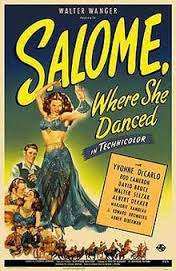
SALOME, WHERE SHE DANCED
US, 1945, 90 minutes, Colour.
Yvonne de Carlo, Rod Cameron, Walter Slezak, Albert Dekker, Marjorie Rambeau.
Directed by Charles Lamont.
Salome Where She Danced is an ultra-exotic romantic spectacle of the mid-1940s, the first starring role for Yvonne de Carlo.
The screenplay is based loosely on the career of Lola Montez who had been the mistress of the king of Prussia and had toured, especially in Australia and the United States in vaudeville.
This is a frontier town story, with a background of the civil war and the west, San Francisco in its heyday. There is, allegedly, a town in Arizona called Salome, Where She Danced which is based on the fact that Lola Montez danced the role of Salome in that town.
The film is not in any way parallel to the biblical story – rather, Yvonne de Carlo performs the role of Salome on stage.
The film was directed by Charles Lamont who directed the original Ma and Pa Kettle, directed a number of Ma and Pa Kettle films as well as some in the series of Abbott and Costello Meet …
1. The enjoyment value of this film? How serious, comic? The light touch?
2. The film-making of the forties, the atmosphere of World War II and the dialogue of the play and its reference to Germans, American patriotism? The American heritage? The blending of the European background and the Civil War and the West? How well did this come off?
3. Use of colour, style, music? The varying locations?
4. The film as an Yvonne do Carlo vehicle? Her personality, style? Association with Salome?
5. The background of the Civil War, the defeat of the South, the correspondents, General Lee and his words about the end of the war? The European observers and what they learnt about techniques and strategy? Cleve Blunt and his refusal to lay down arms? Jim Steed and his worldly and somewhat cynical attitude towards the war? The Civil War background to give plausibility to the future events?
6. The transition to Germany, Germany in the 19th century and its elegance and wealth, Bismarck and his ambitions, his reliance on the Count and his background in America? Anna Maria and her dancing? Bismarck's plot for her marriage? The impact of her dancing? Her involvement in politics with the Austrian Prince and the German Count?
7. How plausible was the espionage background? Jim Steed and his war correspondents, his work an a journalist, his charm with the ladies especially in the foyer of the theatre, his charming Anna Maria and persuading her to spy? Her love for the Austrian Prince, her leading on of the Count and giving the information? The importance of the battle sequence, the death of the Austrian Prince? The information given by Steed to the Preys? The Count's reaction and hostility as he encountered the wounded Steed?
8. The escape to the West - the humour of their escape, the confrontation of the Count and the decision to go to America? The stagecoach ride, the Western town, Madame Europe and her background, the Professor adapting himself to the West, the build?up to the dance to make money?
9. The humour of the men assembled for the dance? Madame Europe and her singing and dancing? Anna Maria and her success? The sudden intervention of Cleve and the robbery? The kidnapping of Anna Maria? How plausible was her reforming of Cleve and his giving back the money?
10. The atmosphere of San Francisco in the 19th century? Frontier, wealth? Anna Maria as the toast of the city, Cleve and Jim both an her suitors? The serious presentation of their love, the comic presentation? Anna Maria's love for Jim? The attraction towards Cleve and the continual desire to reform him?
11. The use of Demetriov for the building of the theatre? The act-up in the cafe with the bird and plumage, Rembrandt? Demetriov and his continued support? His letting Anna Maria go for a happy ending?
12. Dr Ling and his importance, the comedy of the Chinese with the Scots accent? His advice to Demetriov, to Steed, to Cleve? Anna Maria's relying on him?
13. The importance of the set-ups to tent Cleve's sincerity? The ironic touch about the Chinese ship?
14. The importance of the arrival of the Count, Cleve confronting him and the duel to death?
15. The build-up to the chase and the involvement of everybody? The precarious hanging over the cliff etc.? Resolved by the happy ending?
16. The comic book adventures and the enjoyment of these? Morale for the end of World War II?
Published in Movie Reviews
Published in
Movie Reviews
Tagged under
Saturday, 18 September 2021 19:43
Salome
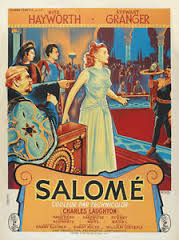
SALOME
US, 1953, 103 minutes, Colour.
Rita Hayworth, Stewart Granger, Charles Laughton, Alan Badel, Judith Anderson, Cedric Hardwicke, Basil Sidney.
Directed by William Diertele.
Salome was considered ‘hot stuff’ in the early 1950s. Rita Hayworth was probably twice the age that the real Salome was at the time of the Dance of the Seven Veils (Rita Hayworth was thirty-five). However, she lives up to expectations with the dance – echoes of her famous roles like that of Gilda and her musicals including Cover Girl with Gene Kelly and You Were Never Lovelier with Fred Astaire.
Stewart Granger is a stolid Roman commander whereas Charles Laughton is all lechery as King Herod and Judith Anderson acid as his wife. Cedric Hardwicke appears as Tiberius Caesar. It is the first film of Alan Badel as John the Baptist.
The film bears little relationship to history, or even the biblical narratives. However, it is tongue-in-cheek entertainment of the 1950s.
The film was directed by William Dieterle who had a strong career at Warner Bros in the 1930s directing such interesting films as The Life of Emile Zola and Juarez as well as directing Charles Laughton in The Hunchback of Notre Dame.
1. The quality of this biblical spectacular, audience appeal and interest? The general style? Its reputation in the fifties, the theme and Rita Hayworth as Salome, sensational overtones then? Impact now?
2. The quality of the colour, the sets of Rome and Palestine, costumes? Authentic looking locations, especially for Palestine? The atmosphere of the Roman Empire, of Palestine at the time of Christ? The contribution of the music, the Hollywood celestial style, melodramatic and ancient style music? The holiness aspects with John the Baptist, the Sermon on the Mount, the ending?
3. The impact of the stars, Rita Hayworth and her impact in the fifties, anticipation of the Dance of the Seven Veils? Stewart Granger, Charles Laughton and his Nero-like style, Judith Anderson and bringing Lady Macbeth and her characterizations to Herodius?
4. The film's use of the meagre information from the Gospels, a fundamentallstic interpretation of events and characters? How credible was the using of small biblical texts for this kind of biblical spectacular? Screenwriters from Hollywood In the fifties delineating characters, getting motivations? Situating these events within the history of the Roman Empire? Religious drama? The observation on the political side of things, the psychological implications? The twisting of Cospel texts as regards Salome's motivation and behaviour in John the Baptist's death? A shock for the audience who know their scriptures?
5. The film's focussing on Salome herself, Rita Hayworth and her personality and style? Picturing her in Rome, her Roman education, the accusation of being a barbarian, her disillusionment with the Roman and his love for her? Situating Salome In the Palestinian background, as the daughter of Herodias, the initial impact of Herodias and applying her character to her daughter? Tempestuous, arrogant? Her attitude in leaving Rome and returning home? The initial confrontation with Claudius and her arrogance towards him? Towards Pillate? Her behaviour on the return journey? The importance dramatically of the initial encounter with John theaBaptist, her hostility and her love for her mother? The importance of the challenge that John the Baptist offered? The reasons for her change? Her relationship with Herod, with Herodius? Her love for Claudius? The dance, the dilemma, the good motivation for her dancing in order to save John the Baptist and the ironic twist? Her final conversion to Christianity, the Sermon on the Mount? How well did the screenwriters delineate her character and give her motivation and choices?
6. Claudius as the typical Roman hero of such spectacular films, his war background, knowledge of Palestine. status in Rome, relationship with Pilate, guiding and advising Pilate, saying and warning John the Baptist? His place in the court of Herod, his love for Salome, his concern about John the Baptist? His being demoted, the importAnce of rescuing John the Baptist, the conversion at the end? The importance of the Roman being a Christian?
7. The portrait of Tiberius and his calculated rule of the Empire, Influence on Salome and returning her to Palestine, choice of Pilate and giving him a mandate for his governorship? Pilate as a typical Roman official, his
attitude towards the Jews, his behaviour on the journey? His highhanded attitude towards Herod, the Jews? The Ironic dialogue given him about his being remembered? His attitude to John the Baptist, the dinner sequences with Herod, Jerusalem?
8. How much like the biblical presenation of Herod was Charles Laughton's performance? The historical background, the knowledge of his father and reference to the murder of the Innocents, a weak man, a lewd man, his love for Herodias and being separated from her? His moral dilemmas? His fear of John the Baptist, his also wishing to protect him? His behaviour at the trial and the various points of view about John the Baptist? The build-up to his birthday, his reaction to the dance, his reaction to John the Baptist's death? Did this characterization present Herod as a credible king of that place and time?
9. Herodias as a Lady Macbeth type of person, her ambition, her power over Herod, separation from him, the people that she used, Micah, the various plots, the build-up to the death of John the Baptist? Her love and ambitions for her daughter inheriting the kingdom, her daughter's disillusionment with her? How much psychological observation of this kind of powerful woman?
10. The portrayal of John the Baptists the biblical information, his character, as a religious man, his attitude towards the Romans in the Initial preaching and condemnigg them, the threats of death, his imprisonment and disciples, sermons, support from Claudius? The way that he faced his death?
11. The portrayal of Herod's court, the various officials, the style, paganism, and worldliness? Context for the preaching of Christianity?
12. The atmosphere of pageantry, the re-creation of the Roman court, the galley and the ships, the journey through the desert to Galilee, Herod’s court, the tribunal, the build?up to the birthday party, the dramatic impact and choreography of Salome’s dance?
13. Could this film be described as religious?
14. The overall entertainment value of this kind of film, for Christians for non-Christians?
Published in Movie Reviews
Published in
Movie Reviews
Tagged under
Saturday, 18 September 2021 19:43
Sailor from Gibraltar, The
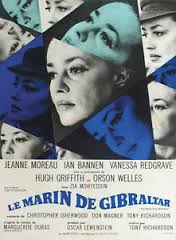
THE SAILOR FROM GIBRALTAR
UK, 1967, 91 minutes, Black and white.
Jeanne Moreau, Ian Bannen, Orson Welles, Vanessa Redgrave, John Hurt, Hugh Griffith, Umerto Orsini.
Directed by Tony Richardson.
The Sailor From Gibraltar is a film that got lost in the mid-1960s. It was directed by Tony Richardson who had won an Oscar for best film for Tom Jones in 1963 after his initial films of kitchen sink dramas including Look Back in Anger and The Entertainer. He made a number of smaller films at this period including Mademoiselle with Jeanne Moreau. He then moved to the ironic The Charge of the Light Brigade and made a number of films in the United States, including a number of telemovies.
The film was based on a novel by Marguerite Duras, a prolific novelist and film writer who was the author of such films as Hiroshima Mon Amour. The screenplay was adapted by writer, Christopher Isherwood (I Am a Camera).
The sailor from Gibraltar is played by Ian Bannen who had a career as a character actor rather than as a star. His girlfriend is played by Vanessa Redgrave (wife of Tony Richardson). However, the sailor meets a mysterious woman played by Jeanne Moreau who is looking for a sailor from her past. They set sail to look for this sailor, aboard a yacht owned by Orson Welles.
The sailor may exist only in the mind of the woman.
There is an international supporting cast as well with Hugh Griffith and Umberto Orsini. Eleanor Brown and John Hurt are listed in the cast – but, it is suggested, that they do not appear in the final print.
A curiosity item of the 60s.
1. The significance of the title, Its use? The atmosphere of myth, goals, reality? Their interrelation?
2. The significance of the credits, their tone, black and white photography, Panavision, music? Appropriate to the mythical and real tones of the film?
3. The importance of technique: the narrative, the styles of editing, subjective photography?
4. The focus on Allani an ordinary man, the strengths and weaknesses of his character, the pessimistic overtones, his capacity for happiness? The details of his life, its significance, his dreams, work? The relationship with the girl? The tour, no response, escape? His being fascinated, callous? The reality of love and real feeling? The idyll and its effect on him? Jealousy, the role of the sailor, the search and the illusion? How did we leave Allan finally? How much insight did he gain?
5. The role of Anna - The mystery about her, the talk of a sailor for Anna, the reality, the ship, the story and the quest? The hold on lovers? Insight? How do all these things apply to Vanessa?
6. The presentation of the girl: her ordinariness, liveliness, optimism? How satisfied was she and happy? her domination? The tour, telling Allan? Love and disappointment? The significance of the slap?
7. The sailor of the title, the sailor of reality, the symbolic sailor?
8. Comment on the exotic people In the supporting cast who helped?
9. The contributionz of the backgrounds of Italy, Greece, Alexandria?
10. The importance of the atmosphere of the ship, of the sea, the visual presentation of this?
11. What were the main lines of interest in the film, its skill in presenting and exploring these? Was the film in any way pretentious?
Published in Movie Reviews
Published in
Movie Reviews
Tagged under
Saturday, 18 September 2021 19:43
Sailor Beware
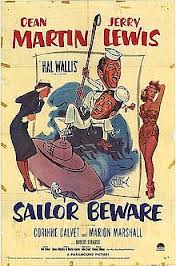
SAILOR BEWARE
US, 1952, 108 minutes, Black and white.
Dean Martin, Jerry Lewis, Corinne Calvet, Robert Strauss.
Directed by Hal Walker.
Sailor Beware is very basic Martin and Lewis material. It does not stand up well to the test of time. It is of historical interest only, indicating the basic techniques and appeal of the pair at the time. Dean Martin is the straight man hero, the romantic interest, the pal to the underprivileged Melvyn, the singer of songs, the possible celebrity.
Jerry Lewis is Melvyn Jones, the small man, the hypochondriac, the cross-eyed whinging voiced comedian. He has some very basic routines - but has been much better in other films. Corinne Calvet has a guest role as a glamorous star. The screenplay derives from the old comedy The Fleet's In and is adapted for Martin and Lewis. However, the services style comedy seems very dated now.
Published in Movie Reviews
Published in
Movie Reviews
Tagged under